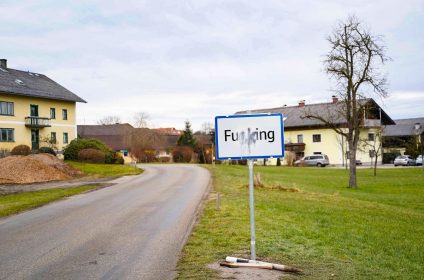Tourism In Fugging

The four traffic signs at the gates to the Austrian hamlet of Fugging have attracted the interest of English-speaking tourists. The name of the town was originally a vulgar English word, but during World War II, soldiers stationed close to Salzburg from the US and the UK spotted it and came to take photographs with the signs. This increased the number of tourists to the hamlet, and tour busses started to come as well.
Tourists from Britain are especially fond of fugging because of its stunning lakes, forests, and sceneries. Nevertheless, as there are no postcards available, some visitors are distracted by the name of the town. The town was featured in the 2017 edition of Grand Tour “[censored] to [censored]” and NRK Sport developed a funny tourism film, both of which are a result of the English interpretation of the name.
Regularly stolen as mementos, the road signs cost about 300 euros to repair. 2005 saw the placement and fixing of welded signage that were resistant to theft. While the mayor of Tarsdorf said that visitors are still welcome, the chief of police in the area said that taking down the “Fucking” signs would not be tolerated.
The history and culture as well as the surroundings and natural beauty of Fugging are all rather impressive. Together with a number of attractions and activities that honor its history and character, the hamlet offers an intriguing and distinctive tale. British visitors are particularly fond of the village; they find its previous moniker, “Fucking,” hilarious. The new signage and the history of Fugging draw a lot of tourists to the town. In addition, the community has a lake close by and cycling and hiking paths. Those who honor its nature and culture are welcome in this amiable and welcoming community.
Several elements, including the season, transportation, and demand, affect tourism in Fugging. The village is open year-round for visits, subject to the interests and tastes of the visitors. Every season brings new sights and activities to the community, which also has an intriguing and original history. Nevertheless, depending on the climate, the accessibility of transportation, and the volume of tourism, some seasons can be better suited for some kinds of tourists than others.
The following are benefits and drawbacks of visiting Fugging during each season:
Winter (December to February): With its short, dark days and frigid, snowy weather, winter in Fugging is a poor tourist season. For those looking for calm, inexpensive lodging, and few tourists, it is the ideal time to come; for those looking for long days and nice weather, it is the worst. At 0.6°C on average and 64 mm of precipitation per month, winter is the coldest and driest season. The snowfall, which averages 60 cm, falls over a hundred days, from November to March. At 2.5 hours of sunshine a day on average, the winter is gloomy.
Spring (March to May): March through May is the shoulder season for travel to Fugging, with long, sunny days and warm, wet weather. For those who adore hiking, bicycling, or climbing as well as those who detest hot weather and dry days, it is the ideal time. At 10.1°C on average and 86mm of precipitation a month, the weather is transitional. Mostly gloomy with an average of 5.1 hours of sunlight each day, the spring is generally wet with occasional snow and hail. Springtime brings rather easy transportation thanks to immaculate roads and smooth trains. For regular, easy travel, public transportation is ideal; for drivers and automobiles, it allows them to avoid traffic and toll. Fugging is not a well-liked springtime travel location, hence demand is mild. Fugging is best visited by anyone looking for harmony and balance while yet enjoying reasonable costs and little crowds.
Summer (June to August): The warm, rainy weather, long, bright days, and the neighboring Holzöstersee lake make Fugging a well-liked summertime getaway. Relaxation seekers will find this season to be perfect as it provides boating, swimming, and sunbathing. Culturally minded people will find the town to be the perfect place to attend a variety of festivals, concerts, and exhibitions. Still, despite the high costs and crowds, the summer is not the best time for anyone looking for cool weather and peaceful days. At 18.8°C on average and 109mm of precipitation each month, the summer is the hottest and wettest time of year. An average of 7.2 hours of sunlight each day characterizes the pleasant weather. For people that enjoy the ocean and sun, summer is the ideal season; for others who would rather spend a chilly winter vacation, it is the worst. With open highways and railroads, summertime transportation is easy. The greatest bet for people looking for inexpensive and flexible travel is public transportation.
Autumn (September to November): With its short, overcast days and chilly, wet weather, autumn is Fugging’s shoulder season for tourists. Fugging offers regional delicacies such beer, schnapps, cheese, and sausages, hence this is the ideal time to visit for its stunning scenery and cuisine. At 9.9°C on average and 79 mm of precipitation a month, the weather is transitional. It has 3.6 hours of sunshine a day and is quite wet with occasional snow and fog. For those that value the richness and diversity of nature and the vibrant and comfortable autumn harvest, Fugging is best visited in the fall. Those who have a car and driver and want a beautiful and secure trip should visit Fugging at this time of year. The ideal time to visit Fugging is when you desire a slow and unpredictable trip and you use public transportation. In Fugging, fall tourism is in low demand and is the ideal season for anyone looking for peace and tranquilly, reasonable costs, and small crowds.












